commentHandler Class Reference
Public Member Functions | |
| commentHandler ($comments, $commentsOwner, $commentLevel, $editLevel) | |
| addComment () | |
| editComment () | |
| deleteComment () | |
| cleanComments ($comments) | |
| replyto ($comments, $depth="", $commentlink, $newcommentid) | |
| numberOfComments () | |
| countComments ($comments) | |
| getComment ($whatcomment, $comments) | |
| renderComments () | |
| renderCommentsActual ($comments, &$listid, $commentlink="", $depth="") | |
| renderCommentsAdder () | |
| renderCommentsDelete () | |
| renderCommentEditor () | |
Public Attributes | |
| $commentsOwner | |
| Who owns that which is being edited? Used to check commenting and editing allowance levels against. | |
| $commentLevel | |
| The access level for editing the comments. | |
| $editLevel | |
| The access level for editing the comments data. | |
| $comments | |
| The array containing blog data. Just let commentHandler handle this - black box stuff, no need to know what's inside ;). | |
| $thisPageURL | |
| This can be set by the user, in case thisPageURL() doesn't return enough information (such as sub-items in a blog entry or gallery items or...). | |
| $commentsChanged = false | |
| This starts false, and will be set to true if the comments have changed (edited, hidden/shown, added, removed...). | |
| $lastCommenter | |
| The person who made a comment (set if commentsChanged == true). | |
| $lastComment | |
| The last comment. | |
| $allowNesting = true | |
| Do we allow nesting the comments? | |
Detailed Description
Class to hangle recursive comments. Use instructions as follows:$commenthandler = new commentHandler($yourCommentsArray, $yourCommentsOwner, $commentingAllowanceLevel, $editingAllowanceLevel); // This is where you input the comments data (to start it off, simply pass an empty array) $commenthandler->renderComments(); // Put this where you wish to show the actual comments $commenthandler->renderCommentsAdder(); // Put this where you wish to show the form for adding a new comment if ($commenthandler->commentsChanged) { // If the comments have changed... You don't actually have to check, but it's good for efficiency $yourCommentsArray = $commenthandler->comments; // Remember to save your comments again, commentHandler does not do that for you! file_put_contents($commentfilename, array_export($yourCommentsArray, "yourCommentsArray")); // Use for example array_export for saving it to file }
Definition at line 28 of file comment_handler.php.
Member Function Documentation
| commentHandler::commentHandler | ( | $ | comments, | |
| $ | commentsOwner, | |||
| $ | commentLevel, | |||
| $ | editLevel | |||
| ) |
Constructor for the comments handler. Use the comments handler as described in the class documentation
- Parameters:
-
comments Comments data array. If you have no array to begin with, simply pass an empty array. commentsOwner String comtaining the user id of the parent data commentLevel Integer containing an allowance level relative to commentsOwner for who is allowed to comment editLevel Integer containing an allowance level relative to commentsOwner for who is allowed to edit the comments
- Returns:
- void
Definition at line 52 of file comment_handler.php.
References $commentLevel, $comments, $commentsOwner, $editLevel, addComment(), array_merge_n(), cleanComments(), commentLevel, deleteComment(), editComment(), editLevel, and thisPageURL().
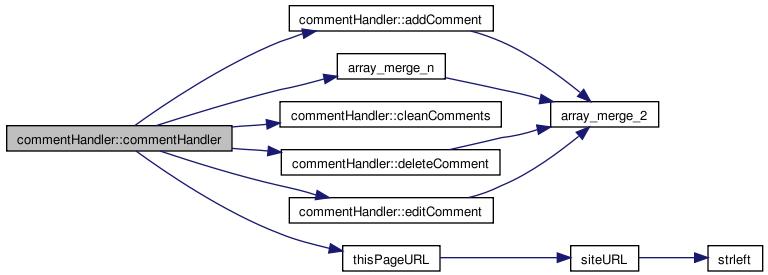
| commentHandler::addComment | ( | ) |
Internal function used for adding a new comment
- Returns:
- array The new comments data array, ready for merging
Definition at line 111 of file comment_handler.php.
References array_merge_2().
Referenced by commentHandler().

| commentHandler::editComment | ( | ) |
Internal function used for editing an existing comment
- Returns:
- array The new comments data array, ready for merging
Definition at line 136 of file comment_handler.php.
References array_merge_2().
Referenced by commentHandler().

| commentHandler::deleteComment | ( | ) |
Internal function used for deleting an existing comment
- Returns:
- array The new comments data array, ready for merging
Definition at line 163 of file comment_handler.php.
References array_merge_2().
Referenced by commentHandler().

| commentHandler::cleanComments | ( | $ | comments | ) |
Internal function used for cleaning up comments data
- Parameters:
-
comments Uncleaned comments data array
- Returns:
- array Cleaned up comments data array
Definition at line 193 of file comment_handler.php.
References $comments.
Referenced by commentHandler().
| commentHandler::replyto | ( | $ | comments, | |
| $ | depth = "", |
|||
| $ | commentlink, | |||
| $ | newcommentid | |||
| ) |
Internal function used for creating the replyto targets
Definition at line 217 of file comment_handler.php.
References $comments, $i, and parse_profilelinks().
Referenced by renderCommentsAdder().

| commentHandler::numberOfComments | ( | ) |
Function which returns the number of comments in the current instance
- Returns:
- int Number of comments
Definition at line 238 of file comment_handler.php.
References countComments().

| commentHandler::countComments | ( | $ | comments | ) |
Internal function used above for counting the comments (the numberOfComments function is a dummy function created to make the API a little prettier)
- Parameters:
-
comments Input a comments data array
- Returns:
- int Number of comments in the comments data array
Definition at line 250 of file comment_handler.php.
References $comments.
Referenced by numberOfComments().
| commentHandler::getComment | ( | $ | whatcomment, | |
| $ | comments | |||
| ) |
Internal function used to get a single comment's data
- Parameters:
-
whatcomment Which comment do you want to grab? comments A comments data structure to get the comment from
- Returns:
- array An array containing the single comment
Definition at line 273 of file comment_handler.php.
References $comments.
Referenced by renderCommentEditor().
| commentHandler::renderComments | ( | ) |
renderComments renders the comments
- Returns:
- string The rendered comments
Definition at line 290 of file comment_handler.php.
References renderCommentsActual().
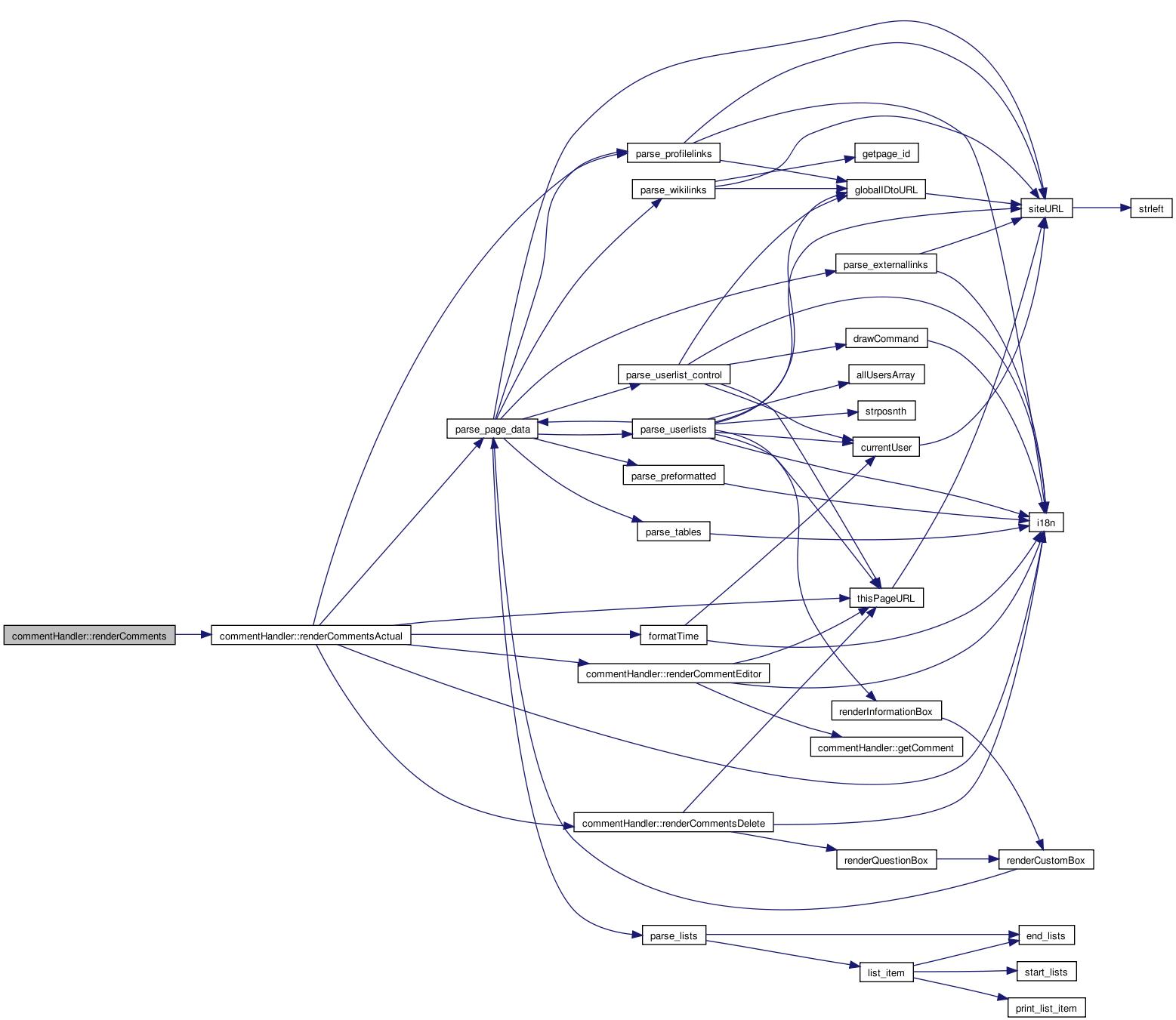
| commentHandler::renderCommentsActual | ( | $ | comments, | |
| &$ | listid, | |||
| $ | commentlink = "", |
|||
| $ | depth = "" | |||
| ) |
The actual comments rendering function. The renderComments function is a dummy function that makes the API a little more pleasant
- Parameters:
-
$comments The comments data $commentlink The link... Just pass "" to this - used internally for recursion $depth How deep are we? Just pass "" to this - used internally for recursion $listid The comment index. Pass a variable $listid = 0 to this - used internally for recursion, for javascript replyto links
- Returns:
- string The rendered comments
Definition at line 308 of file comment_handler.php.
References $comments, $i, commentLevel, editLevel, formatTime(), i18n(), parse_page_data(), parse_profilelinks(), renderCommentEditor(), renderCommentsDelete(), and thisPageURL().
Referenced by renderComments().
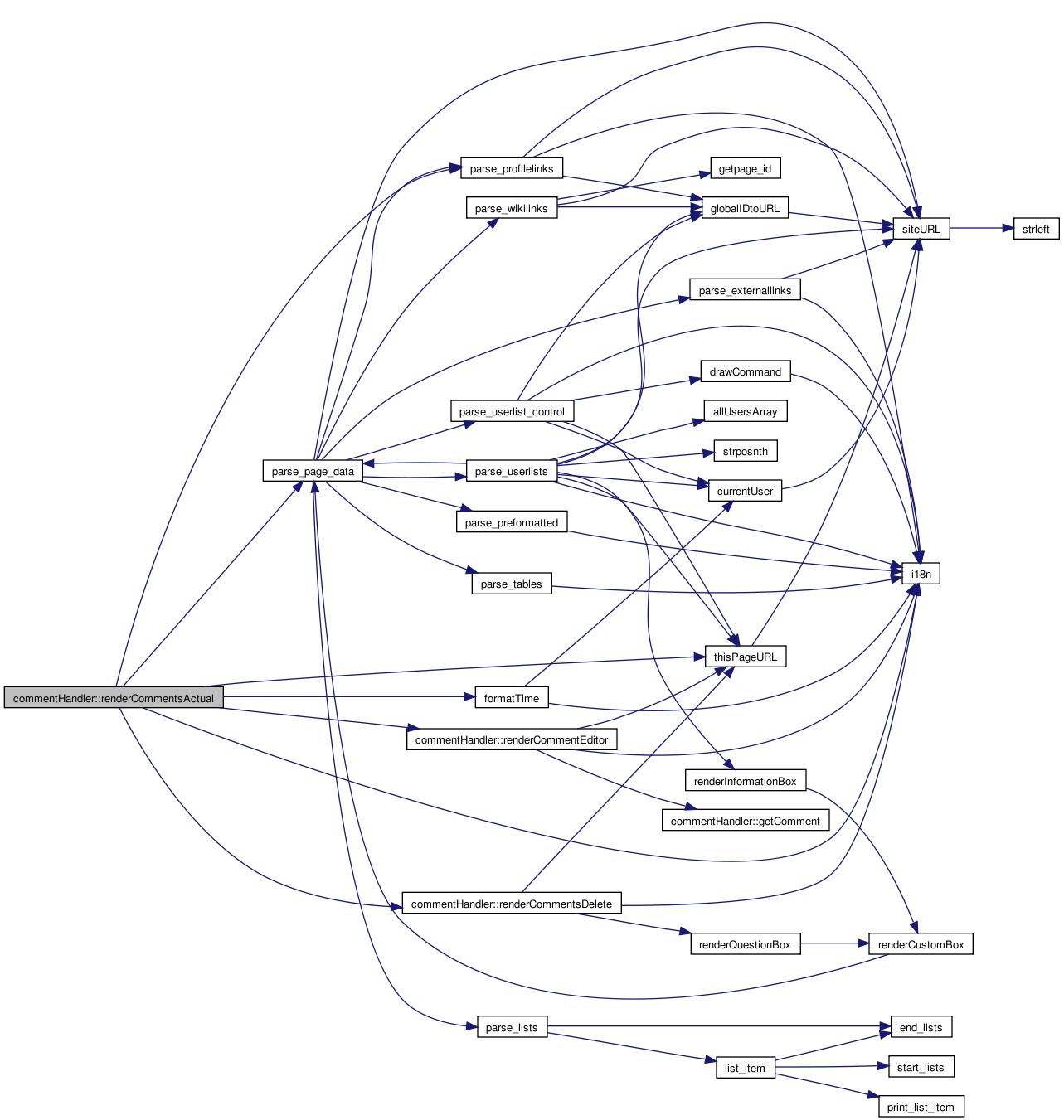
| commentHandler::renderCommentsAdder | ( | ) |
Definition at line 380 of file comment_handler.php.
References $formatting_toolbar, $permissionlevels_array, $systemOptions, commentLevel, currentUser(), formatTime(), i18n(), renderInformationBox(), replyto(), and thisPageURL().
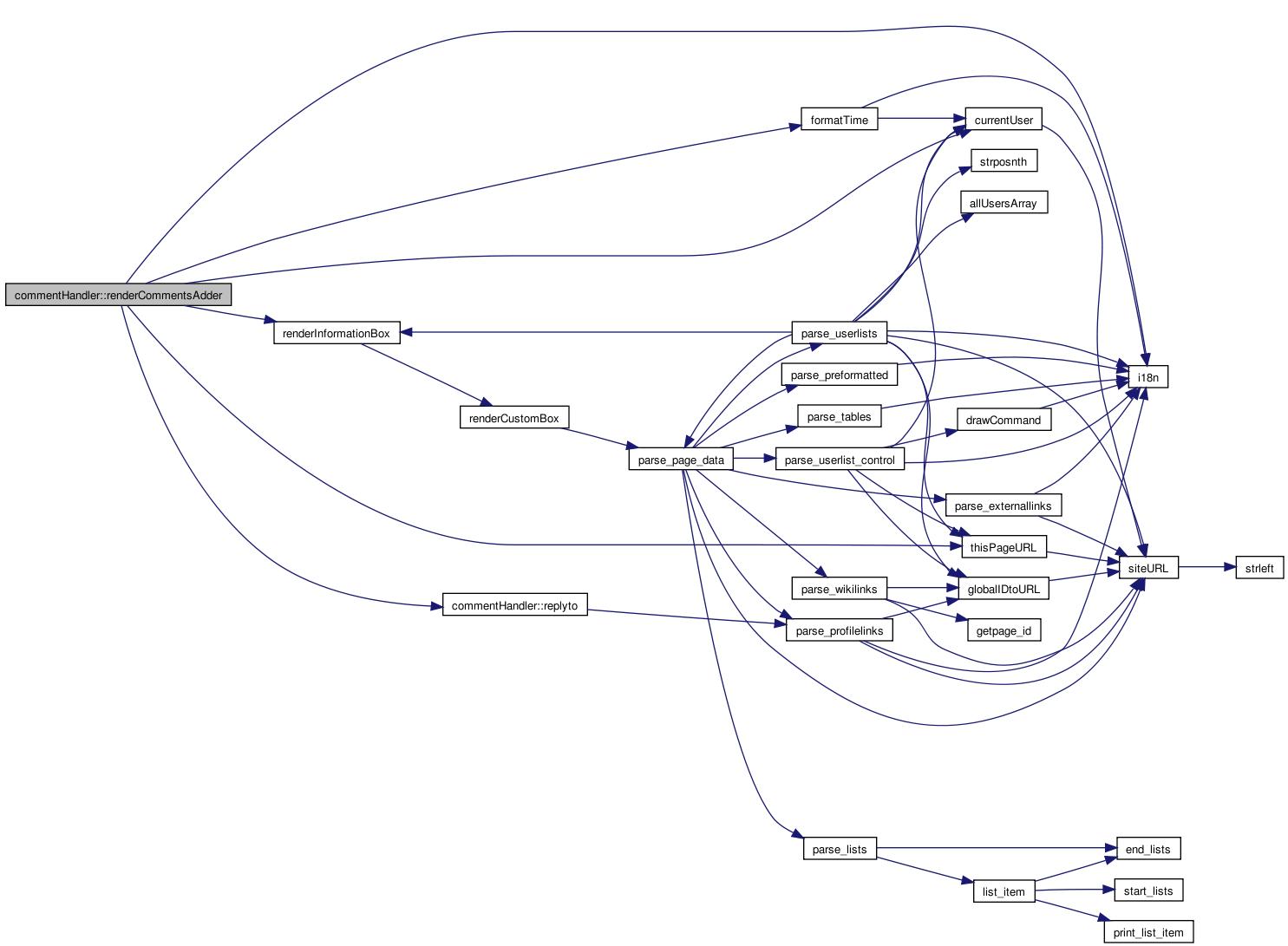
| commentHandler::renderCommentsDelete | ( | ) |
Internal function used for showing the inline comment deletion comfirmation dialog
- Returns:
- string The dialog
Definition at line 441 of file comment_handler.php.
References i18n(), renderQuestionBox(), and thisPageURL().
Referenced by renderCommentsActual().
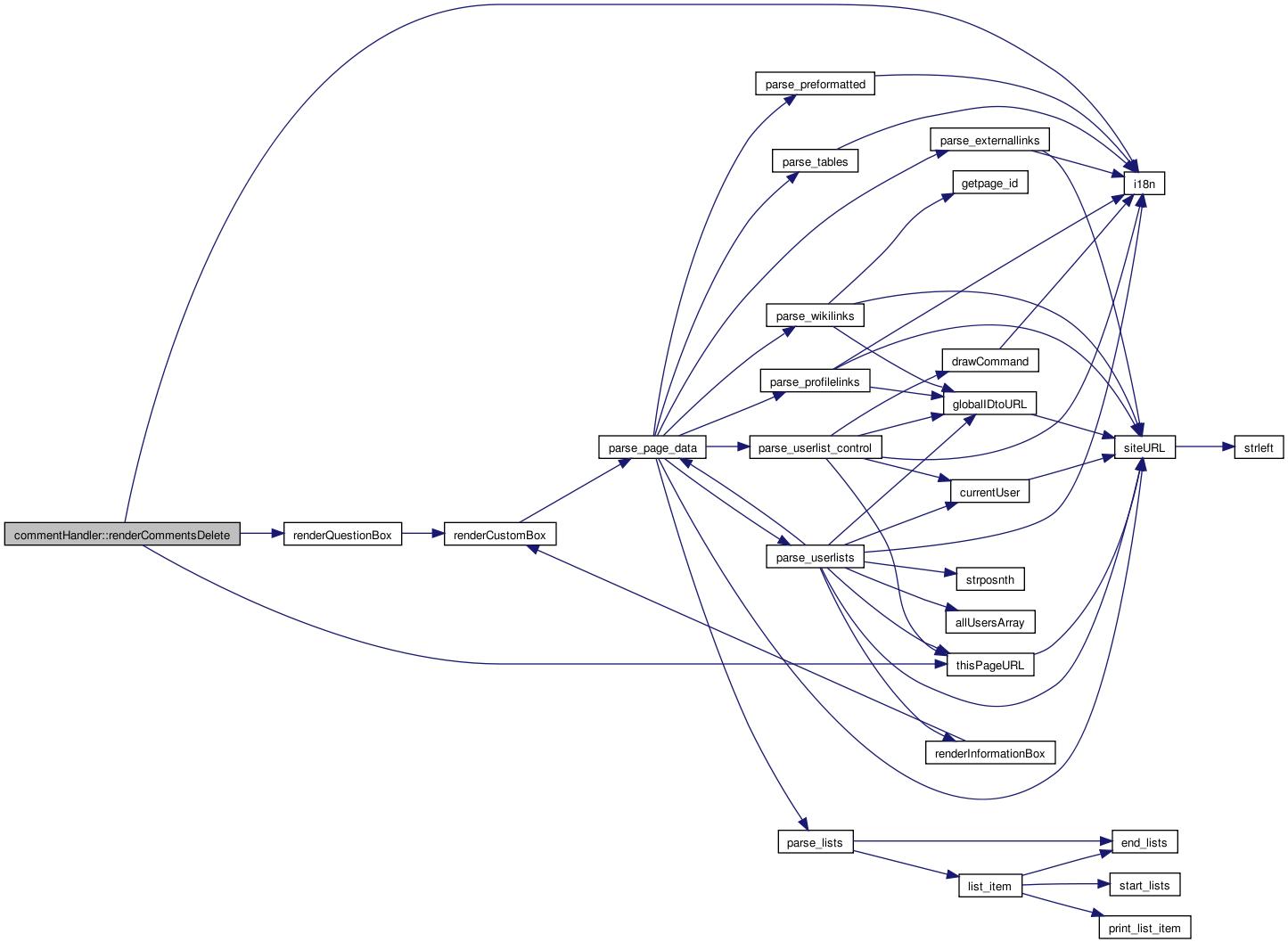
| commentHandler::renderCommentEditor | ( | ) |
Internal function used for showing the inline comment editing dialog
- Returns:
- string The dialog
Definition at line 460 of file comment_handler.php.
References $formatting_toolbar, getComment(), i18n(), and thisPageURL().
Referenced by renderCommentsActual().

Member Data Documentation
| commentHandler::$commentsOwner |
Who owns that which is being edited? Used to check commenting and editing allowance levels against.
Definition at line 30 of file comment_handler.php.
Referenced by commentHandler().
| commentHandler::$commentLevel |
The access level for editing the comments.
Definition at line 31 of file comment_handler.php.
Referenced by commentHandler().
| commentHandler::$editLevel |
The access level for editing the comments data.
Definition at line 32 of file comment_handler.php.
Referenced by commentHandler().
| commentHandler::$comments |
The array containing blog data. Just let commentHandler handle this - black box stuff, no need to know what's inside ;).
Definition at line 33 of file comment_handler.php.
Referenced by cleanComments(), commentHandler(), countComments(), getComment(), renderCommentsActual(), and replyto().
| commentHandler::$thisPageURL |
This can be set by the user, in case thisPageURL() doesn't return enough information (such as sub-items in a blog entry or gallery items or...).
Definition at line 34 of file comment_handler.php.
| commentHandler::$commentsChanged = false |
This starts false, and will be set to true if the comments have changed (edited, hidden/shown, added, removed...).
Definition at line 36 of file comment_handler.php.
| commentHandler::$lastCommenter |
The person who made a comment (set if commentsChanged == true).
Definition at line 37 of file comment_handler.php.
| commentHandler::$lastComment |
| commentHandler::$allowNesting = true |
The documentation for this class was generated from the following file:
 1.5.5
1.5.5